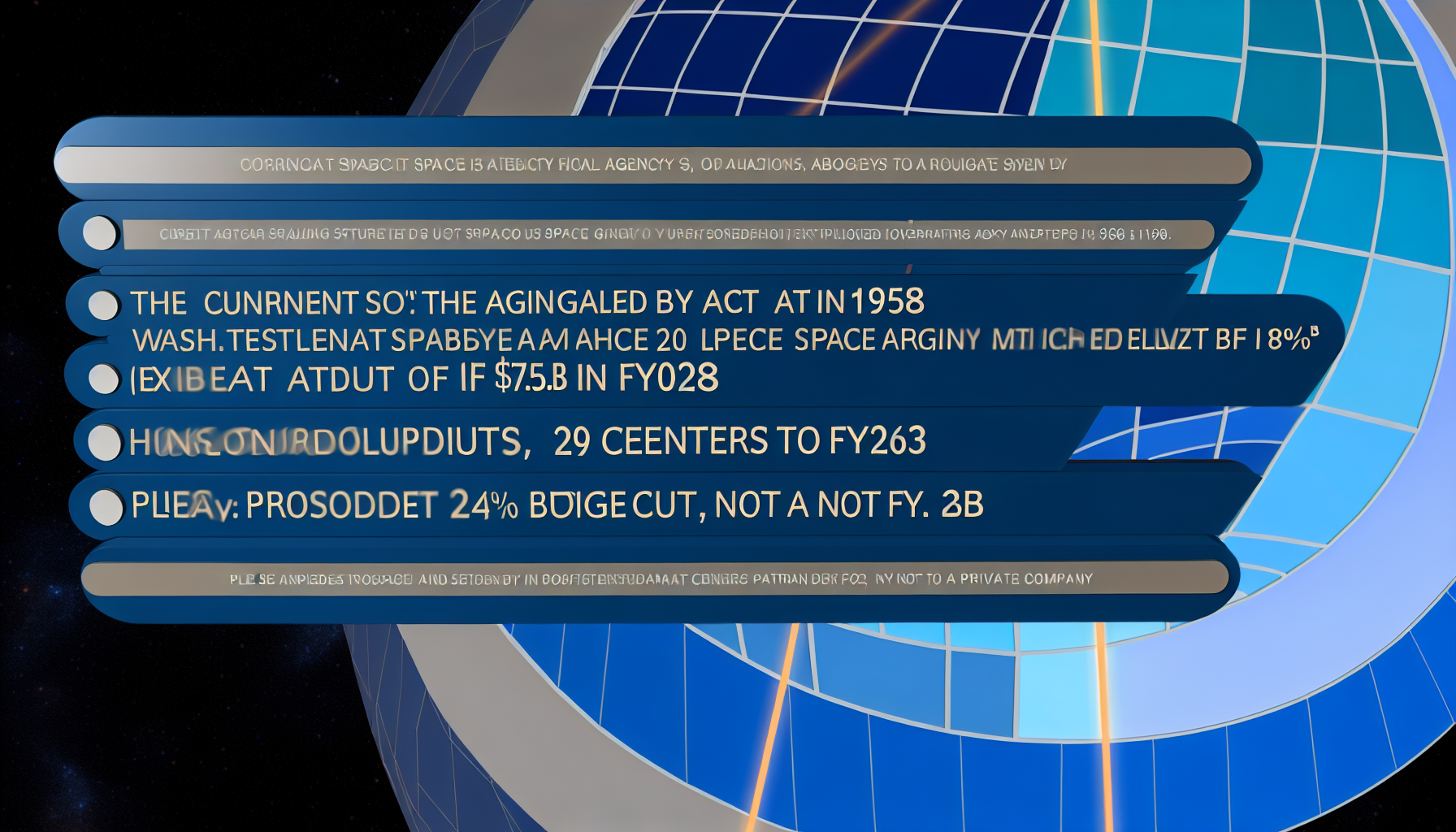NASA agency status is a matter of law, not branding: the National Aeronautics and Space Administration is a U.S. federal civilian agency created by Congress in 1958—distinct from any private company. Its mandate, leadership, and programs are codified in statute, publicly overseen, and nationally funded for peaceful aeronautics and space activities that benefit society. This explainer traces the legal foundation, operations across 20 centers, the $75.6 billion FY2023 economic footprint, and the FY2026 budget debate to clarify what the NASA agency is—and is not. [2]
Key Takeaways
– shows Congress created NASA as a civilian agency on July 29, 1958; operations began October 1, 1958, not a private company. – reveals the NASA agency runs 20 centers and facilities nationwide, coordinating aeronautics and space activities with civilian oversight and international cooperation. – demonstrates a $75.6 billion economic output in FY2023, underscoring public return from research, exploration, and technology transfer across multiple programs. – indicates Title 51 requires a civilian Administrator appointed by the President and confirmed by the Senate, defining statutory functions across NASA programs. – suggests the FY2026 request would cut NASA’s topline 24% to $18.8B and Science by 47% to $3.9B, reshaping mission priorities.
Why the NASA agency is not a company
NASA is not incorporated, does not issue shares, and is not owned by private stakeholders; it was established as a civilian government agency by the National Aeronautics and Space Act, signed into law on July 29, 1958. Operations began on October 1, 1958, explicitly separating civilian space activities from military roles. [2]
NASA’s own description frames the institution as a U.S. federal civilian agency with 20 centers and facilities, currently leading Artemis lunar exploration while pursuing aeronautics research and Earth science—all within a public mission “to explore the unknown in air and space, innovate for the benefit of humanity, and inspire the world.” These are public obligations, not corporate performance targets. [1]
Reference works echo the legal status: the Encyclopaedia Britannica defines NASA as the nation’s civil space agency established in 1958, responsible for programs from Apollo to the International Space Station and Artemis, and funded and governed as a government institution, not a private company. [4]
What the law requires the NASA agency to do
The Space Act created NASA “for the conduct of aeronautical and space activities” for peaceful purposes and directed civilian leadership, coordination, and cooperation with other nations—priorities that are incompatible with profit-maximization as a primary objective. This law anchors NASA’s public-facing, nonmilitary remit. [2]
Today, Title 51 of the U.S. Code codifies NASA’s status and functions. Section 20111 formally establishes the Administration and requires a civilian Administrator appointed by the President and confirmed by the Senate, providing a clear chain of public accountability rather than corporate governance. [3]
Section 20112 details core functions: planning, directing, and conducting aeronautical and space activities; arranging for participation by appropriate U.S. agencies; and encouraging international cooperation. These statutory duties define program priorities, coordination, and reporting obligations in law, not in corporate bylaws or investor agreements. [3]
NASA’s mission statement encapsulates this statutory orientation: “explores the unknown in air and space, innovates for the benefit of humanity, and inspires the world.” Framed as a public good, this is a mission mandate, not a market proposition. [1]
Where the NASA agency operates and what it delivers
The NASA agency runs 20 centers and facilities across the United States, a distributed infrastructure that spans human exploration, space technology, aeronautics, and science. These centers anchor local workforces and supplier networks while enabling national projects such as Artemis, which aims to return humans to the Moon and build capabilities for Mars. [1]
That footprint carries measurable economic weight. NASA reported $75.6 billion in total economic output in fiscal year 2023, reflecting employment, procurement, research investments, and technology transfer that ripple through regional economies. Economic impact is a byproduct of public purpose and statutory programs—evidence of return to the nation from federally funded science and exploration. [1]
Historically, NASA has delivered programs that define eras: Apollo, Shuttle, and the ISS built across decades of public investment and international partnerships. Today, Artemis extends that lineage with new lunar infrastructure and science objectives, while Earth science and aeronautics research continue as core civil missions. The throughline is public responsibility, not private ownership. [4]
What “civilian agency” means for the NASA agency
The Space Act directs nonmilitary aeronautical and space activities to be administered by a civilian agency, clarifying a structural divide with the Department of Defense while enabling collaboration where appropriate. “Civilian” here encompasses public oversight, transparent reporting, and international scientific cooperation, not market competition. [2]
The law also envisions extensive coordination: NASA plans and directs activities, but it also connects with other federal agencies and global partners, reflecting a statutory obligation to share knowledge and foster peaceful uses of space. This mandate makes the NASA agency a hub of cooperative science and technology development rather than a firm competing for market share. [3]
Funding realities for the NASA agency
Because NASA is a federal agency, appropriations and policy shape its scope each year. In June 2025 analysis, the American Astronomical Society reported the FY2026 President’s budget request would reduce NASA’s topline by 24%—from $24.9 billion to $18.8 billion—if enacted, a substantial contraction with program-level effects. [5]
Within that proposal, the Science Mission Directorate would see a 47% reduction to $3.9 billion, with the professional community warning about potential mission terminations, workforce impacts, and shifts in priorities. While the President’s request is the start of the process, the magnitude of the proposed change underscores how public budgeting, not private revenue, drives NASA’s near-term operating environment. [5]
Even amid funding debates, the NASA agency’s economic contribution remains significant: $75.6 billion in FY2023 output reflects high-leverage investments in research and technology that seed innovation beyond government programs. This is the profile of a public R&D engine, not a commercial enterprise. [1]
How media and the public should frame the NASA agency
Precision matters. Calling NASA a “company” obscures its legal foundation, accountability, and mission—and misleads audiences about how programs are initiated, funded, and evaluated. The correct framing is “U.S. federal civilian agency,” created by the 1958 Space Act and governed by Title 51. [2]
Use statutory touchstones when explaining authority and leadership: a civilian Administrator appointed by the President and confirmed by the Senate leads the agency, signaling public accountability through elected branches rather than corporate boards. Pair this with NASA’s mission statement to emphasize societal benefit over shareholder value. [3]
When citing operations and impact, anchor to verifiable figures. NASA runs 20 centers and facilities nationwide and reported $75.6 billion in FY2023 economic output—concrete markers of public infrastructure and return on investment. Reference major programs, from Apollo and the Space Shuttle to Artemis, as long-term public endeavors rather than product lines. [1]
For context, noting that reputable encyclopedic and historical sources describe NASA as the U.S. civil space agency can help inoculate against misinformation. Aligning language to the Space Act, Title 51, and NASA’s own materials keeps reporting accurate and comparable across outlets. [4]
Bottom line on the NASA agency
The NASA agency was created by Congress in 1958 to conduct peaceful aeronautics and space activities under civilian leadership, with duties codified in U.S. law. It operates a nationwide infrastructure of 20 centers, delivers substantial economic and scientific returns, and is funded and overseen through public processes—not markets. Budget swings, including the proposed FY2026 cuts, are political and policy decisions, not earnings reports—another reminder that NASA is an agency of government, not a company. [2]
Sources: [1] NASA – About NASA: www.nasa.gov/about/” target=”_blank” rel=”nofollow noopener noreferrer”>https://www.nasa.gov/about/ [2] NASA History / Public Law 85-568 – National Aeronautics and Space Act of 1958 (unamended): www.nasa.gov/history/national-aeronautics-and-space-act-of-1958-unamended/” target=”_blank” rel=”nofollow noopener noreferrer”>https://www.nasa.gov/history/national-aeronautics-and-space-act-of-1958-unamended/ [3] U.S. Government Publishing Office / govinfo – Title 51 — U.S. Code: National and Commercial Space Programs (selected sections): https://www.govinfo.gov/content/pkg/USCODE-2023-title51/html/USCODE-2023-title51-subtitleII-chap201-subchapII.htm [4] Encyclopaedia Britannica – National Aeronautics and Space Administration: www.britannica.com/topic/NASA” target=”_blank” rel=”nofollow noopener noreferrer”>https://www.britannica.com/topic/NASA [5] American Astronomical Society – The FY26 President’s Budget Request: NASA and NSF Details: https://aas.org/posts/news/2025/06/fy26-presidents-budget-request
Image generated by DALL-E 3











Leave a Reply